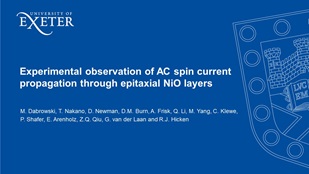
Experimental observation of AC spin current propagation through epitaxial NiO layers
M. Dabrowski, T. Nakano, D. Newman, D.M. Burn, A. Frisk, Q. Li, M. Yang, C. Klewe, P. Shafer, E. Arenholz, Z.Q. Qiu, G. van der Laan and R.J. Hicken
Magnetism and Magnetic Materials Las Vegas, NV Nov 2019
One of the most fascinating developments within spintronics in recent years has been the use of insulating antiferromagnets (AFM) as a medium to transport spin angular momentum. In particular, it has been observed that thin NiO films not only transmit but can also enhance a spin current [1, 2]. So far experiments have been limited to the detection of dc spin current and mainly performed on polycrystalline NiO layers. By employing element specific x-ray ferromagnetic resonance (XFMR) [3] we demonstrate transport of an ac spin-current across epitaxial NiO(001) layers, generated via spin pumping within adjacent NiFe layers. We show that in the case of a FeCo/NiO/NiFe multilayer, magnetization precession at the resonant frequency of the NiFe is also observed in the FeCo, with the phase of the precession being very similar in both layers. The amplitude of the precession of the sink FeCo layer (which is a measure of the amplitude of the spin current propagating through NiO) depends on the NiO thickness. The amplitude reaches a maximum at 6 nm and decays exponentially above this thickness (see Fig.1), in a similar manner to that in both previous experimental reports concerning the dc spin current [1, 2] and theoretical studies [4, 5].
For comparison, we present results for FeCo/NM(5nm)/NiO/NiFe multilayers, where the NiO is decoupled from the sink layer by insertion of a 5 nm thick non-magnetic (NM) layer of Ag or Pd. Although the magnetization precession of the FeCo sink layer at the NiFe resonance can be observed, its amplitude is nearly one order of magnitude smaller than for the case of directly coupled layers. Furthermore, we observe that the precession of the sink layer is characterized by a bipolar variation of the phase that is a signature of spin transfer torque due to propagation of ac spin current through the NiO layer [3]. Our results confirm the propagation of ac spin current within NiO layers mediated by coherent magnons, rather than by the diffusion of thermal magnons.

Figure 1. Ratio of the magnetization precession cone angles of Co (sink layer) and Ni (pump layer) for different thicknesses of NiO layers. The results were extracted from XFMR measurements on MgO(001)/MgO(5nm)/Fe75Co25(5nm)/ NiO(x)/Ni80Fe20(25nm)/MgO(3nm) structures at the excitation frequency f = 4 GHz.
- H. Wang, C. Du, P. C. Hammel, and F. Yang, PRL 113, 097202 (2014).
- C. Hahn, G. de Loubens, V. V. Naletov, J. B. Youssef, O. Klein, and M. Viret, EPL (Europhysics Letters) 108, 57005 (2014).
- J. Li, L. R. Shelford, P. Shafer, A. Tan, J. X. Deng, P. S. Keatley, C. Hwang, E. Arenholz, G. van der Laan, R. J. Hicken, and Z. Q. Qiu, Phys. Rev. Lett. 117, 076602 (2016).
- R. Khymyn, I. Lisenkov, V. S. Tiberkevich, A. N. Slavin, and B. A. Ivanov, PRB 93, 224421 (2016).
- S. M. Rezende, R. L. Rodríguez-Suárez, and A. Azevedo, PRB 93, 054412 (2016).